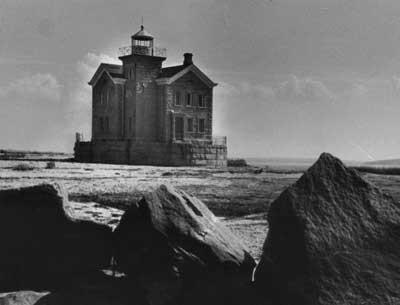County Approves Restoration

An agreement between the Suffolk County Parks Department and the Long Island Chapter of the United States Lighthouse Society will allow the long hoped for restoration of the Cedar Island Lighthouse, which guards the passage between Gardiner’s Bay and Shelter Island Sound, to go forward and its eventual use as a bed and breakfast to become a reality. The agreement was sponsored by Legislator Jay Schneiderman and approved by the County Legislature on June 17.
“I’ve always been interested in historic preservation because of growing up in Montauk,” Mr. Schneiderman said. “The B and B component is the way to continue to upkeep it and to generate revenue,” he said. Michael Leahy, president of the Long Island chapter of the national organization, will oversee the project.
The lighthouse was built in 1868 as an aid for mariners going to and from the busy port of Sag Harbor. It is on a narrow sand peninsula that is part of Cedar Point County Park, but it was on an island until the 1938 Hurricane filled a gap and attached it to the mainland. Decommissioned in 1934 and its beacon replaced by an automatic light on a steel tower, the lighthouse was purchased in 1937 by Phelan Beale, an uncle of Jacqueline Kennedy, who at the time owned 4,000 nearby acres as a game preserve. It later became a summer home, with murals on the dining room walls and oak paneling, for Isabel P. Bradley of Darien, Conn. It remained vacant after the county took it over in 1967, and was gutted by fire in 1974. Even with its windows and doors cemented, it has been subject to vandalism over the years.
“It’s so easy to get to by water, but not so much by land,” Mr. Leahy said, pointing out that driving on the sand spit, which would be difficult at any time, is prohibited between March and August because of nesting piper plovers. Mr. Leahy expects that staying at the lighthouse will be popular because of its remoteness. “My concept is that if you came out here and spent two days you’d have a feeling of what it was like to be here a hundred years ago,” he said.
The lighthouse, constructed of granite, was listed on the National Register of Historic Places in 2003. Interior scaffolding was installed after the fire to keep it from caving in. In addition to two guest rooms on the second story, accommodations for a year-round lighthouse keeper will be constructed on the first. Mr. Leahy said other lighthouses have had considerable success as bed and breakfasts, including the Saugerties Lighthouse on the Hudson River. Green energy, either solar or wind, will be necessary, he said, for electricity.
Mr. Leahy and Mr. Schneiderman see the lighthouse as a tourist attraction. “It’s going to be a balance between the public having access and the people staying there having some privacy,” Mr. Leahy said. The chapter is considering the possibility that a private company would be engaged to ferry day visitors back and forth. Walking tours are now given by Bob Allen, a great-grandson of the last lighthouse keeper.
The first step in the process is to reconstruct the structure at the top of the lighthouse, which held the lantern. It was removed in November and is now at the Sag Harbor Yacht Yard being prepared for refinishing. A ventilator, which sat on top of the lantern when oil was used to light it, has been sent to a foundry in Richmond, Va., where it will be a model for a new one. The top structure will be sandblasted and coated with a water-resistant paint similar to the paint used on bridges. The plan calls for it to be reinstalled in 2015.
Also necessary are a new roof, which will be metal, new windows and doors, and total interior reconstruction. A dock will also have to be built. Mr. Leahy estimates that $2 million will be needed, but, he said, time is on the chapter’s side because the contract with Suffolk County runs until 2029.
“This is really a wonderful part of the maritime history of Sag Harbor and Long Island. . . . I am finding that more and more people in Sag Harbor are getting enthusiastic about it,” Mr. Leahy said.
